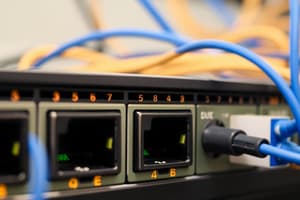Podcast
Questions and Answers
What is the primary characteristic of a Local Area Network (LAN)?
What is the primary characteristic of a Local Area Network (LAN)?
- Covers large geographic areas like cities.
- Managed by multiple service providers.
- Offers high-speed bandwidth and single administration. (correct)
- Depends on wireless connections only.
Which of the following is NOT a component of network architecture focused on reliability?
Which of the following is NOT a component of network architecture focused on reliability?
- Cloud Computing (correct)
- Quality of Service (QoS)
- Security
- Fault Tolerance
What type of threats can internal breaches represent?
What type of threats can internal breaches represent?
- Only accidental breaches by users.
- External denial-of-service attacks.
- Accidental or intentional breaches by employees. (correct)
- Outside hacking attempts through malware.
Which of the following is essential for network scalability?
Which of the following is essential for network scalability?
Which media types are commonly used in networks?
Which media types are commonly used in networks?
What does BYOD stand for in the context of networking trends?
What does BYOD stand for in the context of networking trends?
Which of the following statements about Packet Switching is accurate?
Which of the following statements about Packet Switching is accurate?
Which of the following describes a Wide Area Network (WAN)?
Which of the following describes a Wide Area Network (WAN)?
What is the role of intermediary devices in a network?
What is the role of intermediary devices in a network?
Which characteristic is crucial for ensuring data integrity in a network?
Which characteristic is crucial for ensuring data integrity in a network?
A LAN connects devices over a large geographic area such as countries.
A LAN connects devices over a large geographic area such as countries.
The Internet is described as a global collection of LANs and WANs.
The Internet is described as a global collection of LANs and WANs.
Scalability in a network refers to the ability to minimize failures.
Scalability in a network refers to the ability to minimize failures.
Quality of Service (QoS) is designed to prioritize different types of data like video and voice.
Quality of Service (QoS) is designed to prioritize different types of data like video and voice.
Copper cables, fiber optics, and wireless media are types of intermediary devices.
Copper cables, fiber optics, and wireless media are types of intermediary devices.
BYOD stands for 'Bring Your Own Device' and is a trend in networking.
BYOD stands for 'Bring Your Own Device' and is a trend in networking.
Intermediary devices are responsible for originating or receiving messages in a network.
Intermediary devices are responsible for originating or receiving messages in a network.
Viruses and hacking are considered external threats to network security.
Viruses and hacking are considered external threats to network security.
Access control lists (ACLs) are used primarily in home networks for security.
Access control lists (ACLs) are used primarily in home networks for security.
Packet switching improves network performance by transmitting data in a continuous stream.
Packet switching improves network performance by transmitting data in a continuous stream.
Flashcards
LAN (Local Area Network)
LAN (Local Area Network)
A network covering a small geographic area like a home, office, or campus. It has high-speed bandwidth and single administration.
WAN (Wide Area Network)
WAN (Wide Area Network)
A network connecting LANs over large distances like cities or countries. Usually managed by multiple providers and has slower speeds.
Network Component: End Device
Network Component: End Device
A device where messages begin or end, such as computers, phones, or tablets.
Network Component: Intermediary Device
Network Component: Intermediary Device
Signup and view all the flashcards
Network Architecture: Fault Tolerance
Network Architecture: Fault Tolerance
Signup and view all the flashcards
Network Architecture: Scalability
Network Architecture: Scalability
Signup and view all the flashcards
Network Architecture: QoS
Network Architecture: QoS
Signup and view all the flashcards
Network Security Threat: External
Network Security Threat: External
Signup and view all the flashcards
Network Security Threat: Internal
Network Security Threat: Internal
Signup and view all the flashcards
Network Interface Card (NIC)
Network Interface Card (NIC)
Signup and view all the flashcards
What are networks for?
What are networks for?
Signup and view all the flashcards
What is a LAN?
What is a LAN?
Signup and view all the flashcards
What is a WAN?
What is a WAN?
Signup and view all the flashcards
What is the Internet?
What is the Internet?
Signup and view all the flashcards
What is an end device?
What is an end device?
Signup and view all the flashcards
What is an intermediary device?
What is an intermediary device?
Signup and view all the flashcards
What is fault tolerance?
What is fault tolerance?
Signup and view all the flashcards
What does QoS stand for?
What does QoS stand for?
Signup and view all the flashcards
What is BYOD?
What is BYOD?
Signup and view all the flashcards
What is cloud computing?
What is cloud computing?
Signup and view all the flashcards
Study Notes
Introduction to Networks
- Networks enable global communication for learning, work, and entertainment.
- Communication methods include texting, social media, online collaboration, blogging, and gaming.
Types of Networks
- LAN (Local Area Network): Covers a small area (home, office) with high speed and single administration.
- WAN (Wide Area Network): Spans large geographic areas (cities, countries), using multiple providers and slower speeds.
- Internet: A worldwide network combining LANs and WANs, connected via copper, fiber optic, and wireless technologies.
Network Components
- End Devices: Devices initiating or receiving messages (computers, phones).
- Intermediary Devices: Manage data flow (routers, switches, firewalls).
- Media Types: Transmission methods like copper cables, fiber optics, and wireless.
Network Architectures
- Fault Tolerance: Redundant systems minimizing failures.
- Scalability: Ability to expand without performance loss.
- Quality of Service (QoS): Prioritizes important data like video and voice.
- Security: Protecting data and infrastructure (confidentiality, integrity, availability).
Networking Trends
- BYOD (Bring Your Own Device): Employees accessing company resources with personal mobile devices.
- Cloud Computing: Data storage and access via the internet (public, private, hybrid).
- Collaboration and Video Communication: Tools like Cisco WebEx and TelePresence.
- Smart Homes: Integrating technology into appliances.
Security
- Threats: External (viruses, hacking, denial-of-service attacks) and internal (employee errors or deliberate actions).
- Solutions: Home networks (antivirus, firewalls); large networks (access controls, intrusion prevention systems, VPNs).
Key Terms
- Topology: Network layout (physical or logical).
- NIC (Network Interface Card): Connects a device to the network.
- Packet Switching: Dividing data into packets improving fault tolerance.
Studying That Suits You
Use AI to generate personalized quizzes and flashcards to suit your learning preferences.




